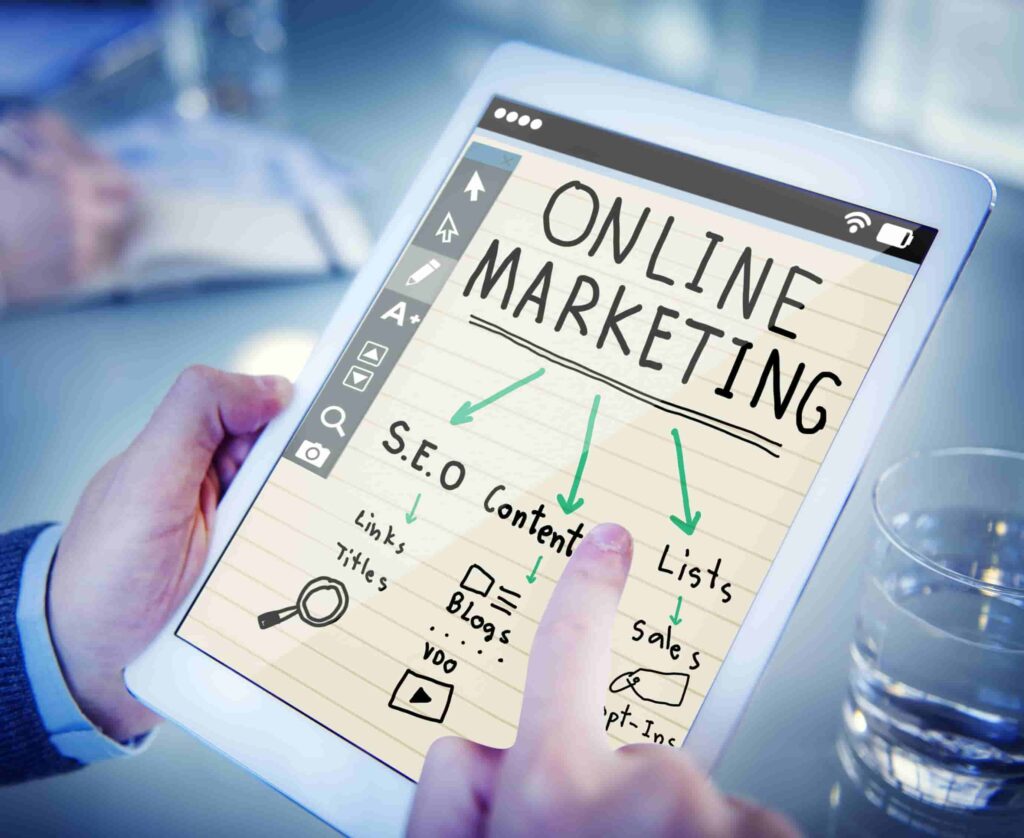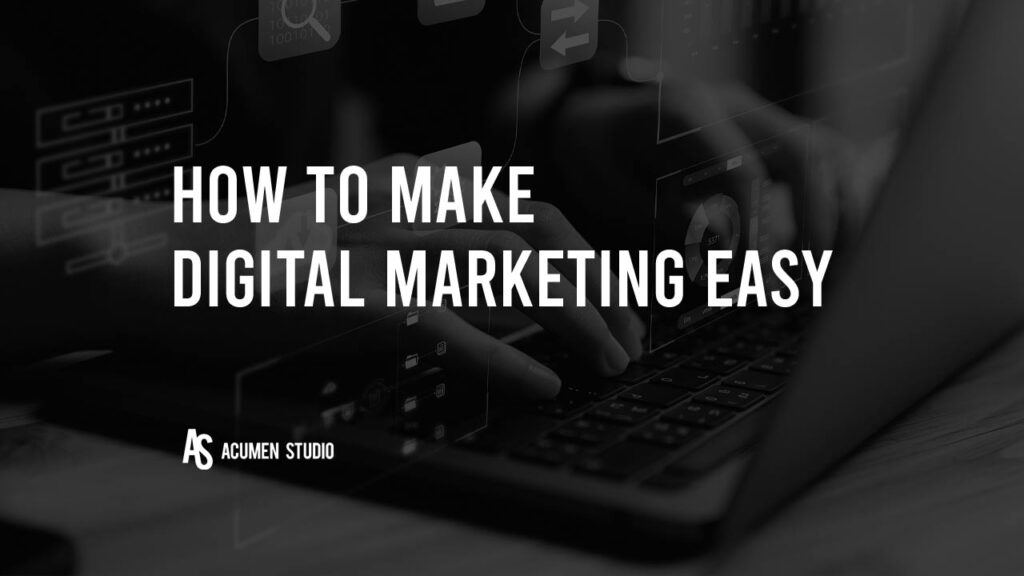Digital marketing is an essential part of any businesses marketing strategy, with there being 4 main types of digital marketing. These are; Search Engine Optimisation (SEO), Pay-Per-Click advertising (PPC), Social Media Marketing (SMM) and Content Marketing. Each type of digital marketing has its own advantages and disadvantages, so it’s important to choose the right one for your business.
Here’s a brief overview of each type:
Search Engine Optimisation (SEO) is the process of improving the visibility and ranking of a website on search engines such as Google. The main aim of SEO is to increase organic traffic to a site through higher rankings on SERPs (search engine results pages).
This can be achieved by utilising keywords throughout website content, as well as other on-page optimisation techniques. Although SEO takes time and effort to see results, it can be extremely beneficial in the long run and is often more cost-effective than paid advertising methods.
Pay-Per-Click advertising (PPC) is a form of online advertising where businesses pay a fee each time their ad is clicked.
PPC ads are generally displayed at the top or bottom of search engine results pages (SERPs), and can also appear on websites and social media platforms. PPC is a great way to drive targeted traffic to your website quickly, however it can be expensive if not managed correctly.
Social Media Marketing (SMM) involves promoting your brand or product through social media channels such as Facebook, Twitter or Instagram.
SMM can be used to build relationships with potential and current customers, create brand awareness, generate leads or drive sales directly. As social media usage continues to grow globally, SMM has become an essential part of many digital marketing strategies.
Content Marketing focuses on creating and distributing valuable content that attracts attention and drives customer engagement.
This could include blog posts, eBooks, infographics or even videos.
Digital marketing is an essential part of any business these days. There are many different types of digital marketing, and each has its own advantages and disadvantages. Here are the four most common types of digital marketing:
1. Social Media Marketing: This type of digital marketing involves using social media platforms such as Facebook, Twitter, and LinkedIn to promote your business. It can be a great way to connect with potential and current customers, build brand awareness, and drive traffic to your website. However, it does require ongoing effort and can be time-consuming.
2. Search Engine Optimization (SEO): This type of digital marketing focuses on improving your website’s ranking in search engine results pages (SERPs). It can be a very effective way to increase traffic to your site and improve your visibility online. However, SEO takes time and effort to implement effectively.
3. Pay-Per-Click Advertising (PPC): This type of digital marketing allows you to place ads on search engines or other websites and pay for each click that they receive. PPC can be a great way to quickly generate leads or sales but can also be quite expensive if not managed properly.
4. Email Marketing: This type of digital marketing involves sending emails to potential or current customers promoting your products or services.
What is Digital marketing | Digital marketing Types | Advantages & Disadvantages explained
What are the Four Types of Digital Marketing?
Digital marketing is the process of using technology to promote your products or services. There are four main types of digital marketing:
1. Search engine optimization (SEO): This is the process of improving the ranking of your website on search engines like Google.
The higher your ranking, the more likely people are to find you when they search for keywords related to your business.
2. Pay-per-click advertising (PPC): This is a form of advertising where you pay a fee every time someone clicks on one of your ads. It can be an effective way to get traffic to your website, but it can also be expensive if you don’t carefully manage your campaign.
3. Social media marketing: This involves using social media platforms like Facebook and Twitter to promote your business. It’s a great way to connect with potential and current customers, and build brand awareness.
4. Email marketing: This involves sending promotional emails to potential and current customers.
It can be an effective way to generate leads and drive sales, but it’s important to make sure that you don’t spam people with too many emails.
What is the 3 Major Part of Digital Marketing?
Digital marketing is the process of promoting a brand or product using digital channels. It encompasses a wide range of activities, including SEO, social media marketing, email marketing, and more.
The three major parts of digital marketing are:
1. Search engine optimization (SEO): This refers to the process of optimizing a website for Google search with the goal of earning higher rankings in the search results pages (SERPs). This can be done through on-page SEO tactics like keyword research and optimizing website content, as well as off-page SEO tactics like link building and guest blogging.
2. Social media marketing (SMM): This involves using social media platforms like Facebook, Twitter, and Instagram to promote a brand or product.
SMM activities can include posting engaging content, running ads, and holding contests or giveaways.
3. Email marketing: This entails sending promotional emails to potential or existing customers with the aim of driving conversions or generating leads.
What is the Most Popular Type of Digital Marketing?
Digital marketing is the process of using electronic devices to promote and sell products or services. It includes a wide range of methods, such as email marketing, social media marketing, search engine optimization (SEO), and online advertising.
Each type of digital marketing has its own advantages and disadvantages.
The most popular types of digital marketing are listed below:
1. Email Marketing
Email marketing is the process of sending promotional messages to potential and existing customers through email.
It can be used to promote new products or services, announce sales or discounts, or simply keep customers up-to-date on company news.
Pros: Email marketing is relatively inexpensive and easy to set up. It also allows you to target specific groups of customers with tailored messages.
Cons: Email campaigns can be time-consuming to create, and it can be easy for recipients to ignore or delete them without reading them. Additionally, spam filters can block some emails from reaching their intended destination.
2. Social Media Marketing
Social media marketing refers to the process of promoting products or services on social media platforms like Facebook, Twitter, LinkedIn, and Instagram. This type of marketing can be used to generate leads, build brand awareness, or drive sales conversions.
Pros: Social media platforms provide businesses with a low-cost way to reach a large audience quickly.
Additionally, social media allows businesses to interact directly with potential and existing customers – building relationships that can lead to increased sales over time. Cons: Managing a successful social media campaign requires significant time and effort – which may not be feasible for small businesses with limited resources.
What are the 5 D’S of Digital Marketing?
Digital marketing has evolved dramatically over the past few years, and today there are several different channels that businesses can use to reach their target audiences. The most common channels include search engine optimization (SEO), pay-per-click (PPC) advertising, social media, email marketing, and content marketing.
The 5 D’s of digital marketing are:
1. Data: Collecting data about your target audience is essential for creating effective digital marketing campaigns. You need to understand who your ideal customers are, what they’re interested in, and what motivates them before you can create content or choose keywords that will resonate with them.
2. Devices: With the proliferation of smartphones and other devices, it’s important to consider how your target audience is accessing your website or mobile app.
Are they using a desktop computer? A laptop? A tablet?
A smartphone? Each device has different screen sizes and capabilities, so it’s important to tailor your content accordingly.
3. Distribution: Once you’ve created great content, you need to get it in front of your target audience.
This means choosing the right distribution channels – such as SEO, PPC, social media, email marketing, or even traditional offline channels like print or television.
4. Dialogue: Digital marketing isn’t a one-way street – you need to engage in dialogue with your customers and prospects if you want to build relationships and encourage conversions. This means responding to comments and questions on social media, replying to emails promptly, and offering customer support when needed.
5. Delight: Finally, don’t forget about the importance of delighting your customers!

Credit: www.leadwithprimitive.com
12 Types of Digital Marketing
Digital marketing is an essential part of any business nowadays. It’s a way to reach out to potential customers and clients through the use of digital channels such as the internet, email, and social media. There are many different types of digital marketing, and each has its own advantages and disadvantages.
Here’s a rundown of 12 of the most common types of digital marketing:
1. Search engine optimization (SEO): This is the process of optimizing your website for Google search with the goal of getting higher rankings in the search results pages (SERPs). SEO can be done on-page (i.e., on your website) or off-page (i.e., through link building and other methods).
2. Pay-per-click advertising (PPC): This is a type of online advertising where you pay for each click on your ad. PPC can be effective for getting quick results, but it can also be quite expensive if you’re not careful with your keywords and targeting options.
3. Social media marketing (SMM): This involves using social media platforms such as Facebook, Twitter, Instagram, etc., to promote your brand or product.
SMM can be very effective if done correctly, but it requires regular updates and engagement with your audience to be successful.
4. Email marketing: This involves sending out mass emails to potential customers/clients in an attempt to promote your product or brand. Email marketing can be quite effective if done correctly, but there’s a fine line between being too promotional and coming across as spammy.
5. Content marketing: This is a type of inbound marketing that focuses on creating valuable content that will attract attention and clicks from potential customers/clients. Content marketing requires regular updates and fresh ideas to be successful . 6 Affiliate Marketing : A form of performance-based marketing in which a business rewards one or more affiliates for each visitor or customer brought about by the affiliate’s own marketing efforts .
7 Inbound Marketing : Inbound marketing is focused on attracting customers through relevant and helpful content , which ultimately leads them further down 8 Display Advertising Banner ads that appear on websites , apps ,and social media platforms .
Digital Marketing Tools
Digital marketing tools are essential for businesses of all sizes. They can help you reach your target audience, engage with customers and prospects, and measure the success of your marketing campaigns.
There are a number of different digital marketing tools available, each with its own unique benefits.
Here are a few of the most popular:
1. Social Media Marketing: Social media platforms like Facebook, Twitter, LinkedIn and Instagram are great channels for promoting your business and engaging with customers and prospects. You can use them to share news, updates and special offers, as well as to connect with people who might be interested in what you do.
2. Search Engine Optimization (SEO): SEO is all about improving your website’s visibility in search engine results pages (SERPs). By optimizing your site for relevant keywords and phrases, you can attract more visitors from organic search traffic – which can lead to more leads and sales.
3. Pay-Per-Click Advertising (PPC): PPC is a form of online advertising that allows you to place ads on SERPs and other websites.
When someone clicks on your ad, they’re taken to your website or landing page where they can learn more about your product or service. PPC can be an effective way to drive targeted traffic to your site.
4. Email Marketing: Email marketing involves sending newsletters, promotional messages or other types of content directly to people who have signed up to receive them (known as subscribers).
It’s a great way to stay in touch with existing customers while also reaching out to new ones.
5. Content Marketing: Content marketing is all about creating useful, informative content that helps solve problems or answers questions that potential customers might have (known as “topics”). This could take the form of blog posts, articles, infographics or even videos.
What is Digital Marketing Strategy
Digital marketing is the process of creating, managing, and executing a marketing plan that uses digital technologies to reach and engage customers. The key components of a digital marketing strategy include:
-Developing a customer-centric approach: Every digital marketing campaign should be designed with the customer in mind.
This means understanding their needs and desires and then creating content and experiences that address those needs.
-Defining your goals and objectives: What are you trying to achieve with your digital marketing efforts? Be sure to set realistic goals that can be measured so you can gauge your progress.
-Choosing the right channels: There are endless possibilities when it comes to choosing which channels to use for your digital marketing campaigns. The important thing is to select the ones that will reach your target audience where they are spending their time online.
-Creating high-quality content: In order for your campaigns to be successful, you need to create content that is interesting, informative, and engaging.
Remember, people are bombarded with content every day, so make yours stand out from the rest!
-Optimizing for search engines: If you want people to find your content, you need to make sure it is optimized for search engines. This means using relevant keywords throughout your website and blog posts as well as making sure your site is easy to navigate.
20 Types of Digital Marketing
Digital marketing is an essential tool in any business’s arsenal. By utilizing a variety of digital marketing techniques, businesses can reach a wider audience than ever before. However, with so many different types of digital marketing to choose from, it can be difficult to know where to start.
To help you get started, we’ve compiled a list of 20 different types of digital marketing:
1. Search Engine Optimization (SEO) – One of the most important aspects of digital marketing is search engine optimization (SEO). By optimizing your website for search engines, you can increase your visibility in search results and attract more visitors to your site.
2. Search Engine Marketing (SEM) – Another important aspect of digital marketing is search engine marketing (SEM). SEM includes both paid and organic methods for increasing your visibility in search results. Organic methods include optimizing your website for SEO as well as creating high-quality content that will attract visitors to your site.
Paid methods include sponsoring ads on search engines or paying for ad space on other websites.
3. Social Media Marketing (SMM) – Social media platforms like Facebook, Twitter, and LinkedIn offer businesses an excellent way to connect with their target audience. Through social media marketing (SMM), businesses can share their content, engage with customers and followers, and build relationships that will promote brand loyalty and encourage word-of-mouth advertising.
4. Email Marketing – Email remains one of the most effective ways to reach customers and prospects online. With email marketing, businesses can send newsletters, announcements, coupons, product information, and other communications directly to their subscribers’ inboxes.Email campaigns can be highly targeted to specific groups or segments of users based on interests or behavior patterns making them an extremely effective form of digital marketing . 5 Pay-Per-Click Advertising (PPC) -Pay-per-click advertising is a type of online advertising in which businesses pay a fee every time someone clicks on one of their ads .
PPC allows businesses to effectively target potential customers who are actively searching for products or services related to what they offer . 6 Affiliate Marketing -Affiliate marketing programs allow businesses to partner with other companies or individuals who promote their products or services in exchange for a commission on each sale they generate . Affiliates typically use their own personal networks or websites as channels through which they market the business’s products or services .
Types of Digital Marketing Platforms
Digital marketing platforms come in a variety of shapes and sizes. Here are some of the most popular types:
1. Social Media Platforms: These platforms allow you to connect with your audience on a more personal level.
Popular social media platforms include Facebook, Twitter, LinkedIn, and Instagram.
2. Content Marketing Platforms: These platforms help you create and distribute engaging content that will reach your target audience. Popular content marketing platforms include WordPress, Medium, and HubSpot.
3. Email Marketing Platforms: These platforms allow you to send targeted emails to your list of subscribers. Popular email marketing platforms include MailChimp, Constant Contact, and AWeber.
4. Paid Advertising Platforms: These platform allow you to place ads on websites and search engines in order to reach your target audience.
Types of Digital Marketing Jobs
Digital marketing jobs are becoming increasingly popular as businesses look to capitalize on the growing digital landscape. There are a variety of digital marketing roles available, each with its own set of responsibilities and skills. Here is a closer look at some of the most common types of digital marketing jobs:
1. Social Media Manager
As a social media manager, you would be responsible for creating and managing social media accounts for a business. This would involve developing strategies to grow followers, engage with customers, and generate leads.
You would also be responsible for creating and curating content, monitoring analytics, and reporting results.
2. SEO Specialist
An SEO specialist is responsible for optimizing website content and architecture to improve organic search visibility.
This involves keyword research, link building, on-page optimization, and more. As an SEO specialist, you would need to have a strong understanding of how search engines work in order to effectively improve a website’s ranking.
3. PPC Manager
A PPC manager oversees all aspects of pay-per-click advertising campaigns. This includes developing strategies, setting budgets, choosing keywords, creating ad copy, managing bids, analyzing results, and making optimizations. As a PPC manager , you must be well-versed in both paid search engine marketing and Google Ads platform management .
4。 Content Marketing Manager A content marketing manager is responsible for planning , coordinating ,and overseeing the creation of various forms of content .This might include blog posts , ebooks , infographics , webinars , or even podcasts .
The goal of a content marketing manager is to create high -quality engaging content that will attract attention from target audiences 5。 Email Marketing Specialist An email marketing specialist is responsible for crafting effective email campaigns .This involves segmenting lists , designing attractive email templates , writing compelling copy , setting up automated drip sequences 6。 Growth Hacker A growth hacker is focused on achieving rapid growth by utilizing creative thinking and out -of -the box methods .This could involve anything from conducting customer surveys 7。 Digital Marketing Strategist As a digital marketing strategist you will be responsible for planning executing 8、and measuring success across all digital channels .
6 Types of Digital Marketing
Digital marketing is the process of using technology to promote your products or services. There are many different types of digital marketing, but six of the most common are:
1. Search engine optimization (SEO): This is the process of making your website more visible in search engine results pages (SERPs).
This can be done through optimizing your website content, building backlinks, and improving your site’s overall user experience.
2. Pay-per-click advertising (PPC): This is a form of online advertising where you pay a fee each time someone clicks on your ad. PPC can be an effective way to drive traffic to your website and generate leads.
3. Social media marketing (SMM): This involves creating and sharing content on social media platforms like Facebook, Twitter, and LinkedIn to build relationships with potential and current customers. SMM can also help improve SEO efforts by increasing brand awareness and generating backlinks.
4. Email marketing: This involves sending promotional or informative emails to a list of subscribers.
Email marketing can be an effective way to nurture leads, build customer loyalty, and drive sales conversions.
5. Content marketing: This involves creating high-quality content that is relevant to your target audience and distributing it through various channels such as your website, blog, email newsletter, social media platforms, etc. Content marketing can help attract new visitors to your site, build trust with potential customers, and boost sales conversions.
6 .Mobile marketing: With over half of all web traffic now coming from mobile devices, it’s important for businesses to have a mobile-friendly presence.
5 Types of Online Marketing
There are many different types of online marketing, but these five are the most common and effective. Paid search advertising, also known as pay-per-click (PPC) advertising, is a form of online marketing where you pay to have your website displayed at the top of search engine results pages (SERPs). This is an effective way to drive traffic to your website and generate leads or sales.
Display advertising is another form of online marketing that involves placing ads on websites or blogs. These ads can be in the form of banner ads, video ads, or text ads. Display advertising is a great way to reach your target audience and promote your products or services.
Social media marketing is a type of online marketing that uses social media platforms like Facebook, Twitter, LinkedIn, and Pinterest to promote your business. This type of marketing can help you build brand awareness, drive traffic to your website, and generate leads or sales.
Email marketing is a type of online marketing that involves sending emails to potential or current customers.
Email marketing can be used to promote new products or services, build customer loyalty, or increase brand awareness.
Affiliate marketing is a type of online marketing where you partner with other businesses in order to promote their products or services on your website or blog. When someone clicks on one of your affiliate links and makes a purchase from the merchant’s site, you earn a commission.
This is an effective way to earn income from your website or blog while promoting other businesses at the same time.
Conclusion
Digital marketing covers a wide range of marketing activities that take place online. It can be broadly divided into four categories:
1. Search engine marketing (SEM) covers all activities aimed at improving the visibility of a website in search engine results pages (SERPs).
This includes optimizing the website content, structure and code as well as building links to the site from other websites.
2. Social media marketing (SMM) encompasses all activities undertaken to promote a brand or product on social media platforms such as Facebook, Twitter and LinkedIn. This can include creating and sharing content, engaging with customers and influencers, running ads and analyzing results.
3. Email marketing involves sending promotional or transactional messages to customers or prospects via email. Common objectives include growing the mailing list, increasing engagement rates and generating sales leads or conversions.
4. Display advertising refers to banner ads and other forms of paid advertising that are shown on websites, apps and other digital properties.



